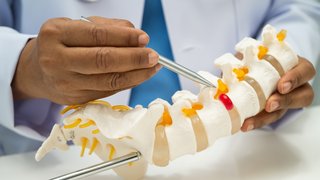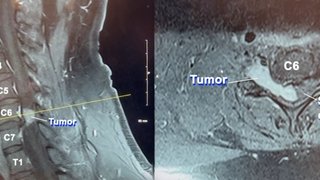Back in action: Updated treatment recommendations for lower back pain
March 30, 2017

That dull ache when you go for your morning jog. A sharp pain when you lift a heavy box. For some people, back pain is just an annoyance that comes and goes. For others, it can be a devastating hindrance to everyday life.
Back pain affects 80 percent of people at some point in their lifetime. Each year, lower back pain causes about 149 million lost days of work in the U.S. and costs $100 billion to $200 billion – mostly in lost wages and productivity.
As The New York Times reported in February 2017, the American College of Physicians and the American Pain Society have released updated back pain treatment guidelines that are similar to the evidence-based approaches we’ve used at UT Southwestern for many years. Many people expect their pain to be treated with a doctor’s visit and a prescription for medication. But we know that’s not how back pain works. And with an opioid epidemic raging in America, prescribing medication as a first-line treatment for back pain is not the safest approach for patients.
Lower back pain often can be resolved by staying active – without pain medication. But there are times when that’s not enough. Let’s discuss when you might need to visit the doctor and when back pain is manageable at home.
When do you need a doctor for back pain?
Most back pain lasts only a few days or weeks. We call this acute back pain, and it usually doesn’t require a doctor’s visit. You might be stiff or have trouble walking, but that’s usually still OK. However, if you have any of the following symptoms along with your back pain, see a doctor immediately:
- Numbness in an arm or leg
- Trouble with bowel or bladder control
- Weakness in an arm or leg
Our spine clinic team includes doctors from a number of specialties. Taking a team approach helps our doctors provide more comprehensive care by identifying seemingly vague symptoms such as digestive trouble or limb weakness and assessing whether the symptoms are spine-related.
Request an appointment with our spine team.
When the team assesses patients with severe back pain, we often recommend physical therapy and pain medication – then we don’t see the patients again because their back pain got better on its own. Staying or getting active with guidance from your doctor can provide ample relief for severe back pain.
Get active to treat chronic lower back pain
Chronic lower back pain is pain that lasts 12 weeks or more. This pain is less likely to go away on its own without treatment. However, the updated guidelines encourage doctors to start with treatments other than medication.
Several years ago, one of the most recommended treatments for chronic back pain was bed rest. Now we know bed rest is one of the worst things to do to treat back pain. In fact, it actually can make the pain worse. Today, for chronic back pain, we recommend maintaining your normal activity level as much as possible. Exercise can improve pain and function in patients with chronic low back pain.
If the pain persists, we recommend scheduling an evaluation from a physical therapist. A physical therapist can teach you how to do special exercises to stretch and strengthen the spine, which should help relieve the pain.
Treating lower back pain without medication
We can use several treatment methods to relieve patients’ pain. Among the nonpharmaceutical techniques we might initially use are:
All of these treatments can improve your pain and mobility. Learn more about behavioral treatments for pain.
- Acupuncture
- Behavioral pain treatment to improve how patients respond to pain
- Heating pads
- Massage therapy
- Spinal manipulation, which involves manual adjustment of the spinal joints
Anti-inflammatory medications to treat lower back pain
If patients don’t improve with nonmedicinal treatments, we can look at medications to relieve their pain. Nonsteroidal anti-inflammatory drugs, or NSAIDs, are the first medicines we try for treating chronic lower back pain when nonmedicinal treatments don’t work. Some examples of NSAIDs available without a prescription are:
Other NSAIDs may require a doctor’s prescription. NSAIDs can be dangerous for some people. In particular, people with ulcers or other gastrointestinal problems shouldn’t have NSAIDs. If NSAIDs don’t work or aren’t recommended for a particular patient, we might recommend skeletal muscle relaxers to relieve back pain.
- Aspirin
- Ibuprofen (e.g., Advil or Motrin)
- Naproxen (e.g., Aleve)
One medication that’s no longer a first-line treatment recommendation for back pain is acetaminophen (Tylenol). Acetaminophen used to be an attractive alternative to ibuprofen and other NSAIDs because it has comparatively fewer side effects, but 2015 findings indicated that acetaminophen wasn’t effective for treating lower back pain. Still, it can be helpful in some patients, and it’s a safe alternative for patients who can’t take NSAIDs.
The dangers of opioids to treat lower back pain
Stronger medications, such as opioid pain relievers, used to be a go-to treatment approach for back pain. Today, we recommend opioids in only the most severe cases.
Opioids cause several side effects, including drowsiness, nausea, difficulty breathing, and constipation. Any of these would be cause for concern, but opioids have the additional major risk of being addictive. People who use opioid painkillers are at serious risk for addiction disorders and physical dependence on the drugs, which can lead to overdoses and even death. That’s why the Centers for Disease Control and Prevention issued guidelines that recommend avoiding the use of opioid painkillers if possible. If we have to use opioids, we use the lowest effective dose for the shortest amount of time to minimize a patient’s risk.
We know this change can be frustrating for patients who have been treated with opioids or other strong painkillers in the past. But we’re here to put our patients’ well-being first. That means we need to try safer treatment approaches first before we consider potentially dangerous painkillers. If your back pain has gotten to the point where opioid medications are potentially needed, carefully discuss the risks and benefits with your doctor.
When it might be time for back surgery
Most of the time, patients don’t need surgery to treat their lower back pain. Surgery almost always is the last resort. But there are times when it’s necessary.
For example, we might consider surgery if a patient has one of the symptoms we mentioned above that warrant an immediate visit to the doctor: numbness in an arm or leg, trouble with bowel or bladder control, or weakness in an arm or leg. These could be signs of a neurological condition. Other symptoms of a neurological condition include trouble using the hands or frequent falls in addition to back pain.
Mechanical issues, or problems with the physical structure of the spine, also are conditions we can correct with surgery. Mechanical issues often show up in one of these ways:
- Back pain that’s worse when moving, sitting, or standing a certain way, as opposed to constant pain
- Deformity or other structural issues with the back
- Pain that’s significantly worse when standing or sitting upright and supporting body weight
And we take particular notice of back pain in patients with a history of cancer. Cancer can spread to the spine – particularly breast cancer and prostate cancer, which are the two forms we see most often in the spine and spinal column. People with a history of cancer need to be more vigilant about back pain that, for someone else, might not be a big deal.
Finding the right treatment
Most cases of lower back pain are comparable to the common cold. They both usually go away on their own, and neither usually needs medication to get better. Regular exercise and nonmedicinal treatments, not powerful drugs, are often our best tools to treat this pain.
Depending on each patient’s unique situation and condition, conservative treatments and over-the-counter pain relievers may not address the underlying problem. In these cases, stronger medications or perhaps surgery might be the answer. Our goal is to provide the right treatment for the right condition, for the right patient, at the right time.
Times have changed, and the practice of medicine changes with time. As we learn more about lower back pain and how it works, we’ll continue to refine our treatment recommendations. But our goal remains the same: using evidence-based medicine to give our patients safe, effective relief from back pain.











